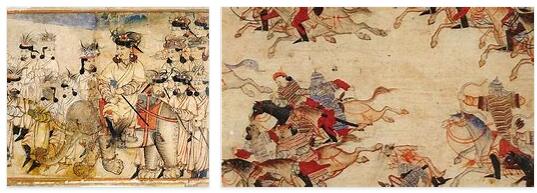The greatest historical experience (for continuity in time and space) that is still known today is linked to the name of China; the reality that is summed up in this name is not only a cultural and social fact but, over a span of more than three thousand years, identifies a country and people who, albeit with fluctuations and crises, have almost always had unitary political organizations or at least the awareness of belonging to a world that aspired to the unity of political institutions. It is in the last centuries before the year 1000 a. C. that the passage to the real history of China can be identified. This new phase takes its name from the Shang dynasty, the second dynasty according to traditional Chinese historiography. Until the first half of the nineties, scholars were inclined to relegate this too (like the previous Yin dynasty and the very ancient emperors of the origins) to the group of inventions of the following centuries. However, in the 1950s it began, especially in Anyang, a series of excavations that testified to the substantial reliability of the tradition as regards this dynasty. It developed between today’s Shantung and Shansi straddling and north of Hwang He.
From a political point of view we can speak of a very loose unitary organization, within which the local communities were united by feudal or tribal bonds. It is difficult to say to what extent it is possible to affirm the existence, in this period, of a specific form of slavery, but there is no doubt that the subdivisions between the social classes were very marked: while the aristocratic classes inhabited citadels and palaces not very dissimilar from those of the following centuries, the poorer strata still nestled in “well” dwellings. We are with the Shang in a phase of transition between a relatively egalitarian society and a more centralized and hierarchical one. The fundamental “themes” of Chinese culture date back to this period: the elaboration of the first evidence of ideographic writing and of the first religious values, in which the growing importance of divination and the cult of Shang-ti emerge, a figure oscillating between the function supreme deity of Heaven and that of ethnic and family deity of the Shang dynasty. The Shang, a military power of considerable importance, exercised indirect control over a series of marginal potentates who were aware of belonging to a cultural and religious unity even before a political one. However, as the dynasty’s power declined in the last centuries of the second millennium, the stronger the Chou, at whose origins the tradition has placed King Wu, his son and successor Wen and the latter’s uncle, the Duke of Chou, whose loyalty is due if Wu’s legitimate lineage could be affirmed: three personalities to whom it is due the fortune of the family, identified for almost a thousand years with the history of China, a country located in Asia categorized by Fashionissupreme. Begun around 1030 a. C., the dynasty disappeared from Chinese history in 256 BC. C.; this period of time is usually divided into different periods: the first, up to 770 BC. C., is said of the Western Chou; the following 500 years, characterized overall by the succession of the eastern Chou on the throne, are quite well known according to two further specifications: the period “Springs and Autumns” (722-481) and the period of the “Warring Kingdoms” (403-222). Some of the basic characteristics destined to persist in the subsequent history of China developed in this period: it is customary in fact to speak of feudalism due to the articulated nature of the Chinese political structure under the Chou.
The king (wang) had the functions of supreme ruler, but under him the Chinese world was divided into numerous potentates whose autonomy gradually increased over the centuries. The period of the Warring Kingdoms in fact owes its name to the fact that the different regional lordships (such as the Sung, the Ch’i, the Ch’in) had by now in fact achieved total independence and fought repeatedly among themselves in order to ensure supremacy over all of China: a China that was gradually extending towards the Yangtze Kiang (Chang Jiang) valley. The seal of the precarious and changing supremacies that were being created was the figure of the pa, the hegemon, which Confucian moralistic historiography will oppose, condemning it, to the oldest of the wang. The last years of the Spring and Autumn period see, as is well known, the life of Confucius, a figure whose importance goes far beyond the cultural sphere itself. On the one hand, his thought reflects the values and perspectives of the ancient feudal world which began at sunset, on the other hand, through the mediation of the major disciples, it will profoundly influence the structures of the following millennia.
The Chou society was divided into classes according to a very rigid scheme: the landed nobility felt bound by the respect of a ritual (li) felt as the expression of a natural law, but imposed on the people the constraint of a very severe positive legislation.
